1950: As Powell Goes, So Go Cavers
This team may have been the best of all coached by Duane Maley at San Diego High, but the Cavemen lost two of their best players and five reserves as practice started and their best player at the most important time of the season.
They came up short in the Southern California playoffs.
Starting halfback Darnes Johnson and tackle Ed Wallace were gone before the first scrimmage.
Johnson was the team’s leading ball carrier and a :09.8 100-yard sprinter who anchored the Hillers’ rapid 880-yard relay team in the spring. Wallace was an experienced lineman who saw playing time in 1949.
UNCLE SAM BECKONS
Halfbacks Richard Real, Paul Brooks and Mickey Hall, end Howard Simpson, and guard Calvin Rayford joined Johnson and Wallace, also literally hauled out of school and ordered to report to National Guard units at Fort Rosecrans on the Point Loma peninsula.
The Korean War erupted on June 25, 1950, when the North Korean army invaded South Korea. American ground troops aided the South Korean cause.
The seven National Guard Cavers were called to duty to help take the place of those deployed.
Maley soon learned there would be no “education deferments.” The only games the players would be playing were war games.
The players had joined the National Guard in high school partly because each earned as much as $10 for every meeting attended, a handy sum for teenagers of the era.
Active duty was expected to be in the future, after graduation.
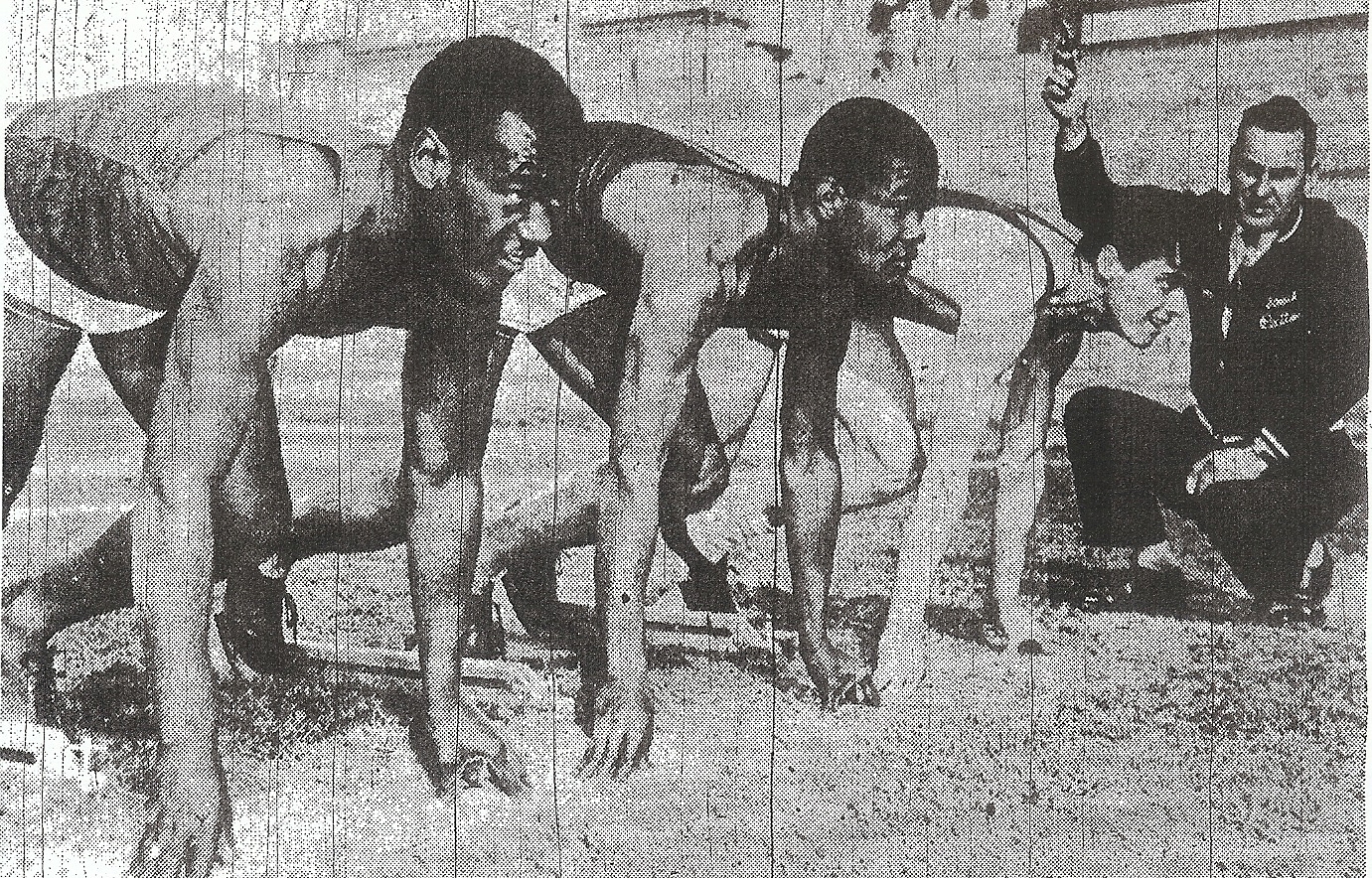
Deep and fast, San Diego overcame the personnel losses and stormed through the new City Prep League to finish the regular season with an 8-0 record.
But disaster struck in game 7.
End Charlie Powell, who would be named Southern California player of the year, sustained a bruised kidney after taking a knee in his back during a 58-12 romp over Kearny, the poorest team on the schedule.
Of all the games to lose the star player in Southern California and arguably the best in the country! San Diego went into the Kearny game with an overall 29-pound average weight advantage, 184-155.
The Cavers led, 27-0, after one quarter and 58-0 after three.
Powell did not play the following week against La Jolla, the original thinking that he would be available for the opening round of the playoffs.
Medical reports soon indicated a more serious injury.
The 6-foot, 3-inch, 230-pounder, a marvelous player who excelled in 4 sports (the only athlete in school history to earn 12 varsity letters in three years) , including track and field (he held the school shot put record of 57 feet, 9 1/4 inches, for 31 years) and baseball in the spring, was declared out several days before the first-round game at Fullerton.
No mystery. No intrigue. No wait for a game-time decision.
Powell not only missed the game but also part of the basketball season.
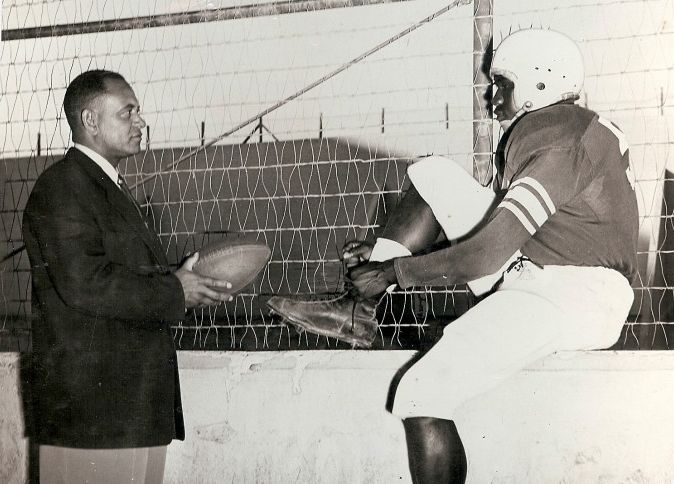
TOPPED POWELL’S FLAG TEAM
Without Powell San Diego still was favored by a touchdown over the 7-1-1 Fullerton Indians.
Without “Ness” Johnson the Cavemen still had explosion.
Frank Johnson and Harold Espy combined for 20 touchdowns. Chuck McDairmant was completing 57 per cent of his passes and had thrown for more than 800 yards.
McDairmant’s play at quarterback was a final, important ingredient. Completing his second season as starter, McDairmant’s eight-game total was 47 completions in 83 attempts for 810 yards and 12 touchdowns.
At one point during the season McDairmant was averaging 10.27 yards per pass. Evening Tribune writer Jerry Brucker was moved to compare the Hillers’ signal caller to the Los Angeles’ Rams’ Norm Van Brocklin, the NFL leader at 9.28 yards per pass.
McDairmant had been a relatively anonymous end on the Hillers’ 1948 sophomore team, but Maley moved him to quarterback the following spring and the junior-to-be won the job.

McDairmant also had some “cred”, although that term did not become a part of the social lexicon until years later.
The Horace Mann Junior High team of McDairmant, Terry Heselius and Bruce Dietrick had won the three-man City touch football championship by defeating the Memorial triumvirate of Powell, Espy, and Darnes Johnson.
NATIONAL ANTHEM, THEN NO GAME
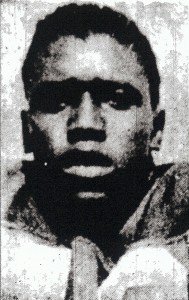
The loss of Powell was just one of Maley’s concerns. The coach was uneasy before the 8 p.m. Friday kickoff at Fullerton High. A dense fog was rolling in, blanketing much of Orange County.
Players on both teams were ghost-like figures in a surreal pregame warmup, rhythmically appearing and disappearing.
“I couldn’t see the holder or the kicker I was snapping the ball to,” remembered center Fred Thompson, looking back years later on one of his most disappointing experiences.
To Maley’s almost disbelief, the stadium public address announcer declared a weather postponement, the first in CIF Southern Section playoff history, after the national anthem.
The Cavers were forced to spend the night in Fullerton.
“It was crazy, the way the coaches worked it out,” said Thompson.
“There must have been forty-five or fifty players who made the trip. They had us spread out all over Fullerton. I spent the night with 5 or 6 other players in the fire station. I slept on a cot. We were awakened every time there was any activity by the firemen.”
THE LONG WAIT
A long morning wait on Saturday preceded the 2 p.m. kickoff. Forces seem to be working against the Cavemen.
And why, with an 8-0 record, was Maley’s squad the visiting team? Against an opponent that had a loss (19-0 to South Pasadena) and a tie (0-0 with Whittier) before winning six in a row?
With an oddly timed coin toss nine days before the game to determine where the teams would meet, especially since Fullerton still had a regular season game on its schedule?
Conspiracy theorists cited another example of perceived CIF Southern Section bias. The Southern Section numbered more than 200 schools, the great percentage of which were at least 100 miles north of San Diego, the so-called “Border Town”.
Fullerton proved a tough, worthy opponent.
Expected to grind it out and try to maintain ball-control, the Indians struck twice with touchdown passes in the third quarter after a 6-6 deadlock in the first half. San Diego answered with touchdowns each time but a missed extra point in the fourth quarter left the Cavers short.
Final score, 20-19.
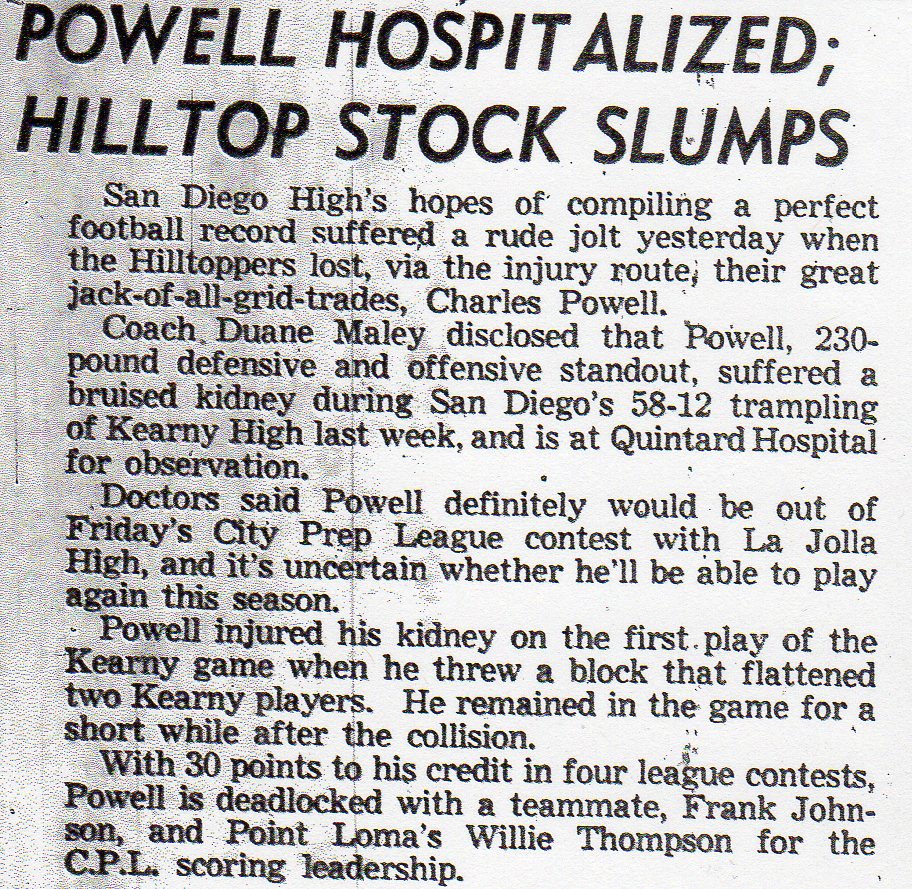
WHAT ELSE?
Had the Hillers made the conversion and the game ended 20-20, San Diego would have advanced to the semifinals of the 10-team bracket, having more first downs than Fullerton. That CIF rule would come into play again in 1955, when the Cavers met Anaheim in an epic semifinal playoff.
The last indignity came late in the game. An apparent 15-yard touchdown run by Frank Johnson that would have put the San Diego in front, 25-20, was erased because of a rarely called rule infraction.
A San Diego lineman was penalized because his foot was lined up inside the foot of the lineman next to him.
“We had scored and I had my hand up to signal for the huddle (for the extra point),” Thompson recalled. “Then I heard the referee scream, ‘Illegal formation!’ I had no idea what was going on. I saw the referee go over to the sideline to explain the penalty. Maley was beside himself.”
A LEAGUE OF THEIR OWN
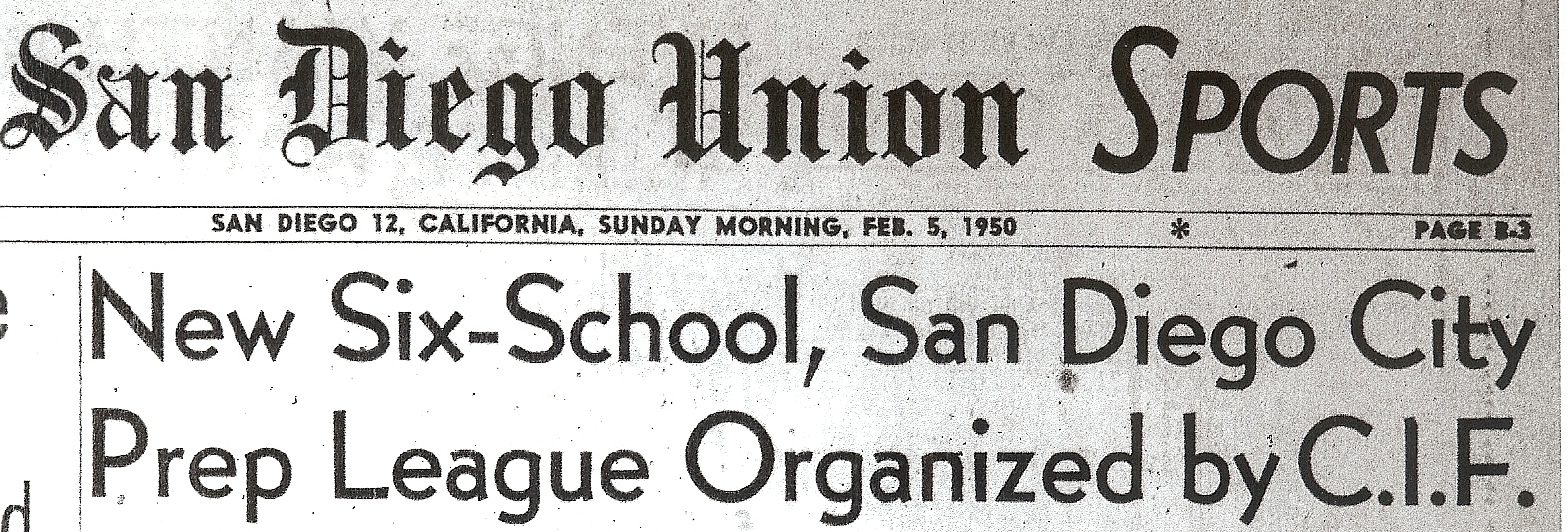
Hoover principal Floyd Johnson, the San Diego representative on the CIF Southern Section executive committee, was in Los Angeles in February, 1950, for a weekend meeting at which the new San Diego City Prep League was formed and the Metropolitan League was realigned.
The City League would consist of San Diego, Hoover, and Grossmont, holdovers from the Coast League; and La Jolla, Point Loma, and Kearny, former Metropolitan League entries.
Metro membership went to Sweetwater, Chula Vista, Coronado, Oceanside, Escondido and Mar Vista, which became the 22nd County school, opening its doors with a temporary campus near the Brown Field air station.
The Southern Prep presented the same lineup as in 1949. Mountain Empire, in distant Campo, was given a “passive” membership. Its representatives would attend league meetings and the Redskins would abide by SPL rules, but they played a limited league schedule.
Brown Military also remained in the SPL but would not play San Dieguito.
St. Augustine, as usual, was not a factor, wearily traipsing to and from schools in the far-flung, Los Angeles-dominated Southland Catholic League.
The Saints would mount a strong campaign for admittance to a San Diego league later in decade.
And what a decade it would be! From 1950-59 San Diego High was 85-15, the best record of any school in California. More significant, 10 new schools were welcomed as San Diego County nudged toward a divorce from the Southern Section.
BALLOT SUCCESSFUL
One of the new schools would be Helix, which was scheduled to open in September, 1951, with split sessions at Grossmont while the Highlanders’ facility was constructed.
East County voters in November, 1950, overwhelmingly passed a bond issue for $1.9 million that financed what was then known as the “University Avenue High school.”
The Helix address became 7323 University Avenue in La Mesa.
MUSTANGS ROAM WITH REID
San Dieguito was more fortunate than the San Diego Cavemen in the Minor Division playoffs.
Riding the heavyweight thrusts of Bud Reid, who finished the season with 16 touchdowns, the Mustangs defeated Metropolitan League co-champ Escondido, 13-0, then followed with wins at Brawley, 33-20, and over Palm Springs, 12-0.
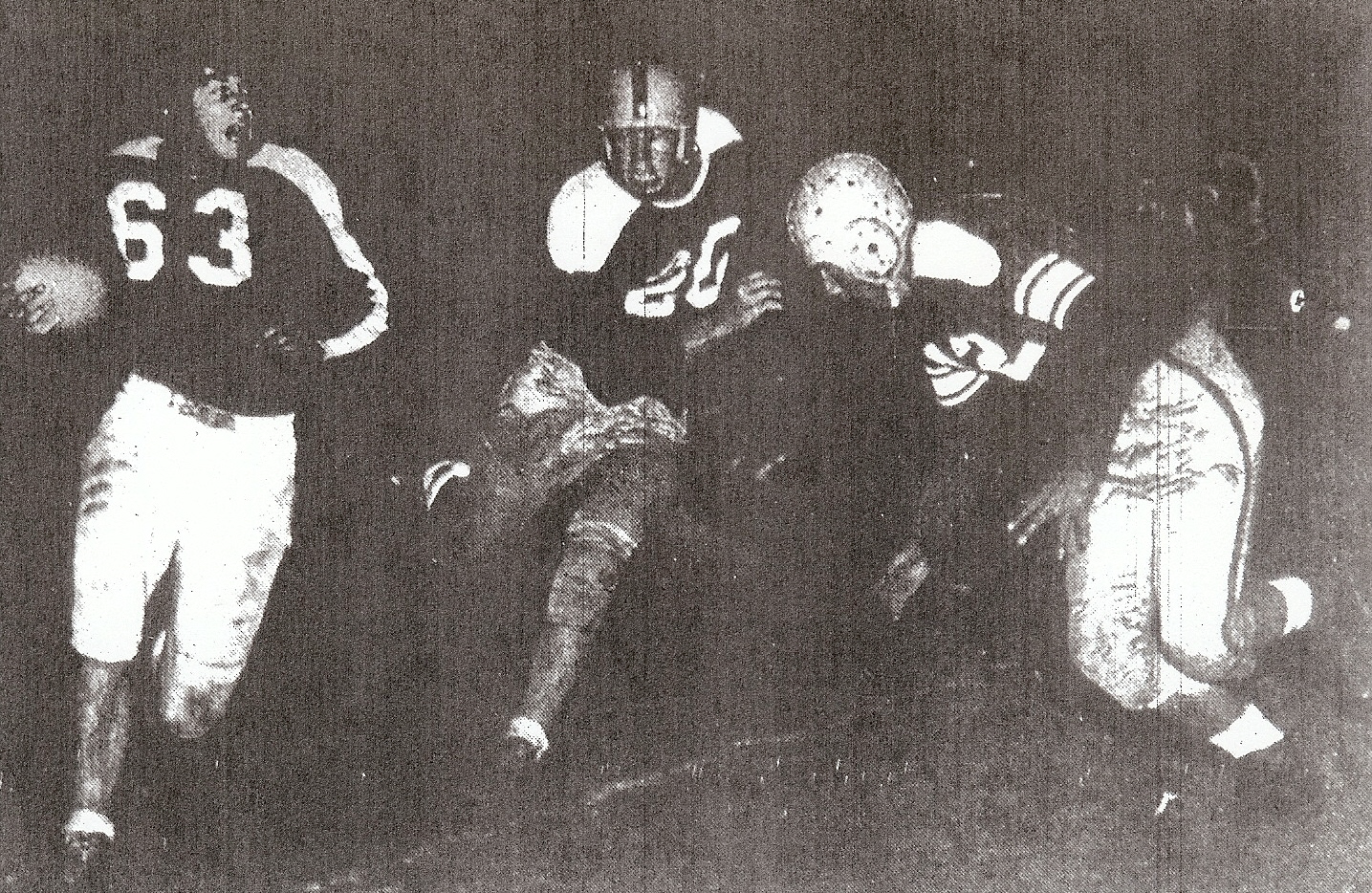
Mustangs supporters were only slightly assuaged. They continued to be miffed at what they saw as disrespect for the school’s athletic program and lack of consideration when the re-leaguing of the 21 San Diego County schools took place earlier in the year.
San Dieguito wanted to sit at the big table, in the Metropolitan League, but was consigned to the weaker Southern Prep League.
Mar Vista, located in the supposedly more geographically suited South Bay and opening in September, 1950, would give the Metropolitan League its desired six teams, although Mariners games wouldn’t count in the league standings the first year.
San Dieguito, in the north San Diego County Encinitas community, claimed its second straight SPL title with a 4-0 record and outscored league rivals Army-Navy, Ramona, Fallbrook, and Vista, 142-19.
The Mustangs would join the Metro League in 1951.
HOW GOOD WERE POWELL AND CAVERS?
It’s no surprise Charlie Powell was the Southern California player of the year despite playing only 6 1/2 games and, with Powell healthy, the Cavers arguably were one of the top teams in the state.
Powell played running back, pass-catching end, and defensive end and could turn a game either way.
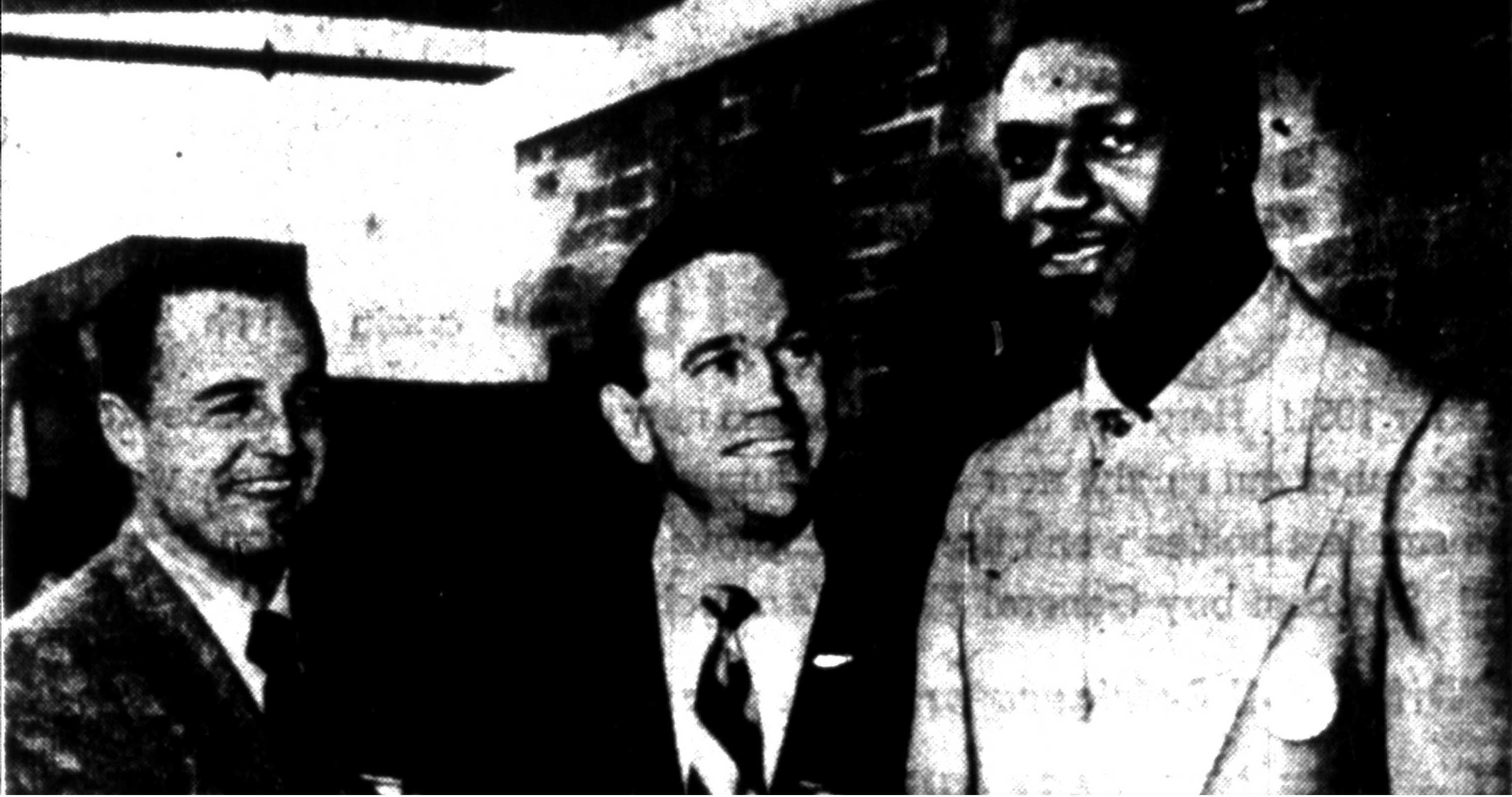
The tall, graceful Powell astounded the crowd of more than 8,000 in Bakersfield by running down and making an open field tackle on halfback Hal Morgan, a 49-seconds quarter-miler and one of the fastest athletes in the San Joaquin Valley.
Morgan, who gained 40 yards on the play and reached the Cavers’ 10-yard line, was injured on the tackle and did not return. Powell also ran for a first down with a bad snap from punt formation.
The Cavers had brought the game to the 6-0 Bakersfield Drillers, scourges of the CIF Central Section, after a five-hour bus ride.
Hal Espy scored on the first play of the game with a 72-yard dash. San Diego held Bill Fanning, the Drillers’ leading rusher, to 19 yards and the Cavers eased to a 19-7 victory over coach Homer Beatty’s club, which was averaging 32.3 points and wreaking havoc from Fresno to the Grapevine on U.S. 99.
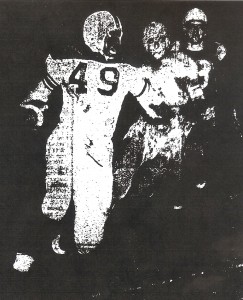
As Bakersfield Californian writer Eddie Lopez noted, “Never before in all six of their previous games have the Drillers faced such dazzling speed, beefy forwards, and devil-may-care gambling as illustrated by the visiting Cavers.”
PRINCIPALS, BUTT OUT!
Local observers generally were pleased with the alignment of the new San Diego leagues, with some reservations. Evening Tribune sports editor George T. Herrick did not like the idea that league games were scheduled by draw, coordinated by school principals.
Herrick suggested coaches would have done a better job. The schedule “pitted traditional teams against each other too early in the year,” said Herrick, who pointed out that every city school except La Jolla claimed its lowest attendance in several years at home games.
Particularly galling, said Herrick, was the scheduling of San Diego and Hoover in the league opener at Aztec Bowl as a Hoover home game. The game drew 10,000 in the 11,500-seat stadium at San Diego State, not far from the Hoover campus. Attendance was half that of the 1949 game at Balboa.
City League officials, when announcing the schedule, indicated they wanted to minimize traditional rivalries. Point Loma and La Jolla, old antagonists from the Metro League, also were paired in a City League opener.
Evening Tribune writer Jerry Brucker reported that CPL bosses felt the San Diego-Hoover game had gotten “too big” and needed to be deemphasized.
Tradition also took a back seat when San Diego High’s acclaimed Sergeanettes did not perform. A new rule prohibited the band and drill teams of visiting schools from participating in pregame or halftime ceremonies.
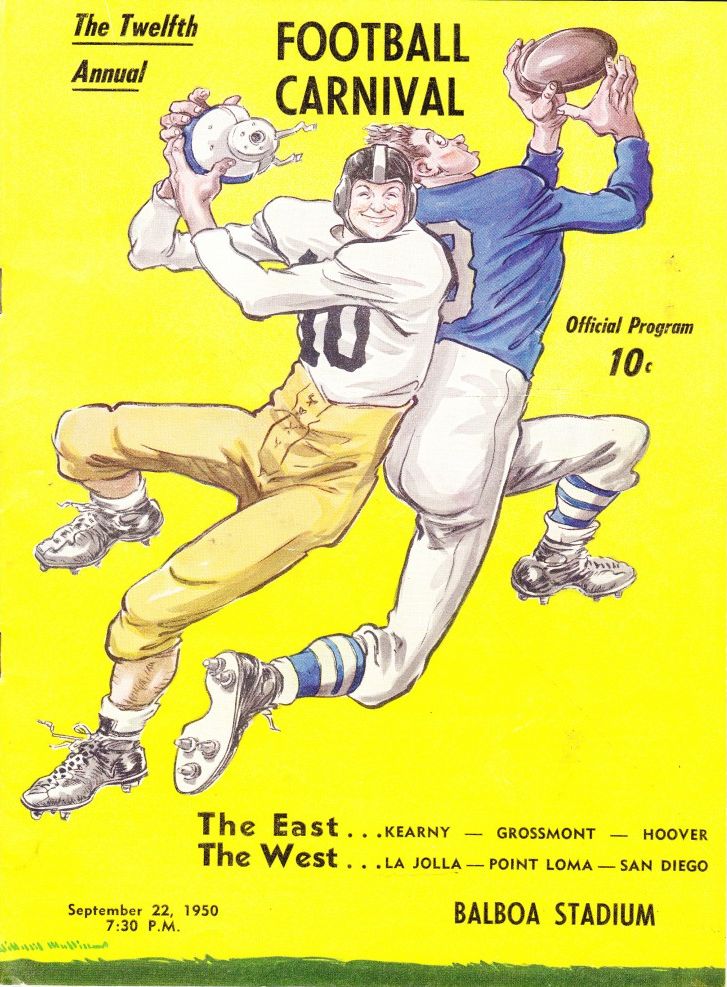
WEST WINS 12TH CARNIVAL
The pageantry and precision of ancillary groups was appreciated by the official crowd of 20,526 persons which turned out for the 12th annual City Schools football carnival.
The West of San Diego, Point Loma, and La Jolla, defeated the East of Kearny, Hoover, and Grossmont, 18-8 in a perfect, East-West geographical alignment of three, 15-minute quarters.
Point Loma’s Marshall (Scooter) Malcolm returned a kickoff 89 yards for a touchdown against Grossmont and La Jolla’s Oscar Ruiz scored two touchdowns against Kearny. San Diego and Hoover were scoreless.
HONORS
Powell was joined in the all-Southern California lineup by halfback Frank Johnson and tackle Terry Heselius, teammates who made the third team; Coronado halfback Harry Sykes, who earned second team honors, and Point Loma halfback Marshall (Scooter) Malcolm, a third team choice.
Future San Diego State and Chargers assistant coach and St. Louis Cardinals head coach Jim Hanifan of Covina, was Powell’s accompanying first-team end. Guard Jack Menotti of Santa Monica, later the head coach at Madison and Ramona, earned second-team honors.
LIGHTS, FINALLY
Hoover at last introduced its new lighting system as 4,500 showed to watch the Cardinals tie San Bernardino, 14-14.
New lights had been purchased in time for the 1949 campaign but were late arriving and the Cardinals played the ’49 schedule on the road.
La Jolla installed new lights at Scripps Field on campus. Point Loma erected concrete bleachers, and Kearny acquired land to enlarge its athletic plant.
COACHES DISSED
The Breitbard Athletic Foundation announced that a “San Diego Board of Football” had been formed. Writers Gene Earl and John McDonald of The Union; Jerry Brucker and Tom Stansberry of the Tribune, and F.W. (Bill) Whitney of the Breitbard Foundation would select the all-City and all-Metropolitan League teams.
Coaches would be asked only to fill out ratings cards on opponent players the Monday following games. The writers would analyze and make choices, supposedly removing selection politics and coaching agendas.
WELCOME TO COACHING, COACH
Head coach Gerry Spitler summed up the first season at Mar Vista:
“A few weeks ago we were greeted by thirty-five boys, five of whom lettered in junior varsity football at Chula Vista; a practice field full of rocks, and a coaching staff (Bob Ganger, baseball, and Don Smith, basketball) new to the game.”
Players walked the field before the first practice, picking up rocks and using their helmets as buckets. A student contest resulted in the naming of the school and its teams (Mariners) and colors (green and gold).
Mar Vista students attended classes at the abandoned Naval Air Base at Brown Field near the U.S-Mexico border while the new school was being constructed.
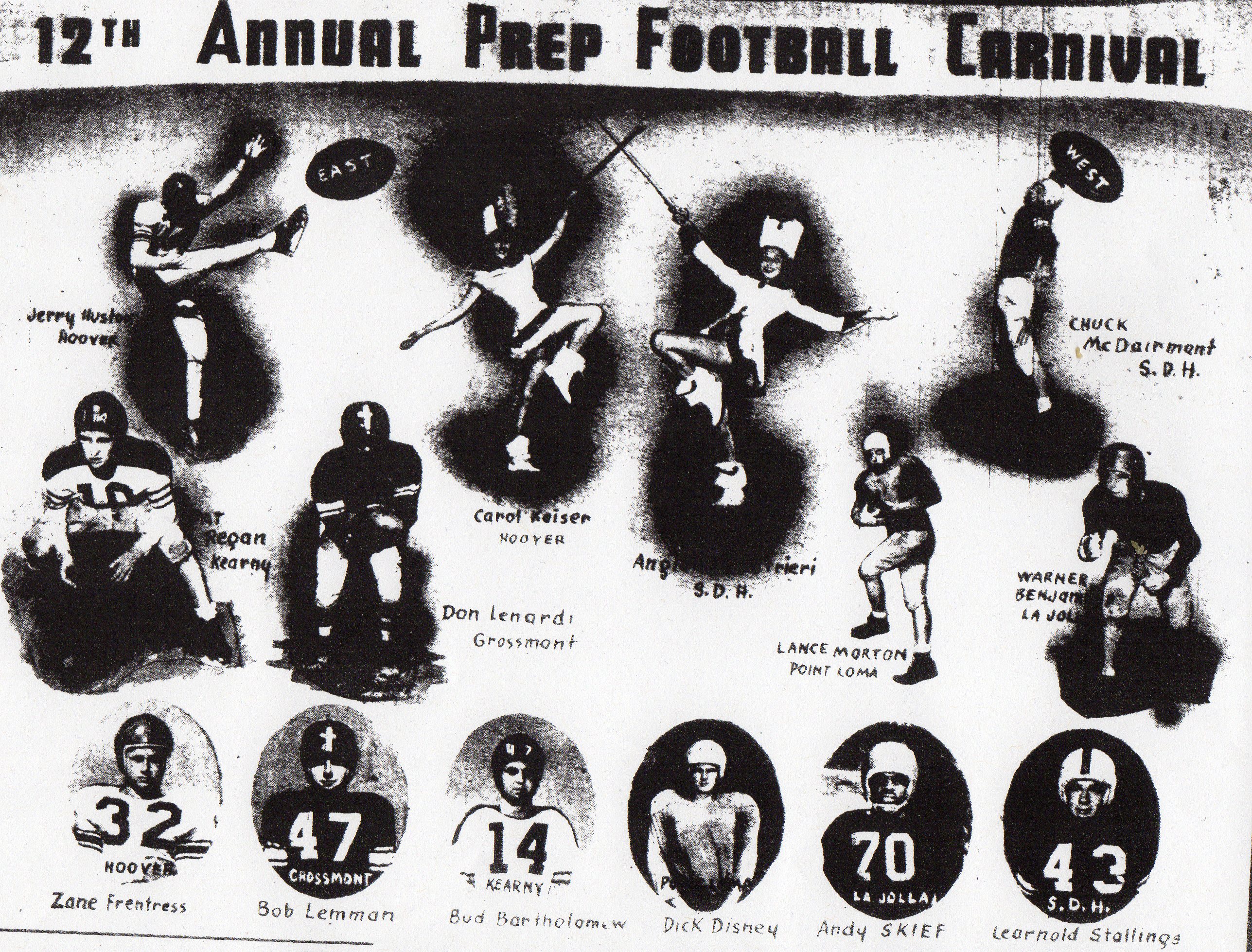
Sweating through an opening-game, 26-0 loss at Corona, Spitler declared, “The first quarter was the longest in my life!” Mariners players committed numerous penalties resulting in a 49-minute opening period.
WITHER BREITBARD GAME?
The summer’s second annual College Prep game, matching all-Los Angeles against all-Southern California, was won by the L.A. City team, 27-7, before an estimated 15,000 in Balboa Stadium.
Several days later game founder Bob Breitbard told the Evening Tribune‘s George T. Herrick that there would not be a third game between recent high school graduates. The popular contest had been a financial loser, said Breitbard.
Foundation executive director Leo Callan went before the city council in January, 1951, revealing that the 1950 game lost $1,100.
Callan, advancing Breitbard’s wish that the game be saved, sought a break in the rental fee for Balboa Stadium and also announced that a group in Los Angeles wanted the game if Breitbard bailed.
La Jolla’s Sid Davis scored the losers’ only touchdown with an 88-yard kickoff return in the last minute.
TRUE GRID

Compton, trailing, 14-6, in the third quarter, defeated Fullerton 26-14 for the Southern Section championship… San Diego won its opening game 14-2 over Long Beach Poly before 9,000 at Long Beach Veterans’ Memorial Stadium in a renewal of a preeminent Southern California rivalry…the Cavers and Jackrabbits met 30 times between 1910 and ’41 but they had not played since 1944…La Jolla, under new coach Walt Harvey, and Point Loma, led by the veteran Don Giddings, proved to be able replacements for teams from the Coast League…Point Loma beat Hoover and hung in against San Diego… Hoover played Glendale, Arizona, and San Diego played Glendale, California… the Cavers averaged almost 11 yards a carry and hammered Glendale with 323 yards on the ground… Frank Johnson had 151 yards in 9 carries, Eddie Duncan 79 in 8, and Hal Espy 88 in 6…Powell ran 63 yards on an end-around for a touchdown and scored on pass plays of 27 and 69 yards in the 33-21 victory over Point Loma…the Kearny Komets scored only 21 points and were 0-5 in the City League, prompting criticism of their inclusion in the new lineup…head coach Hal Smith was a one-man staff…he did not have an assistant coach…Hoover had two players named Bill Reed, one a guard, the other a fullback, no relation…with two touchdown passes to Hal Espy against Fullerton, San Diego’s Chuck McDairmant finished with 14 in nine games…St. Anthony forfeited to St. Augustine after discovery that the Long Beach school had scheduled Newport Harbor on the same night… fiery Hoover coach Bob Kirchhoff promoted several sophomores to the varsity and slashed the number of players dressing for home games after successive losses to San Diego and Grossmont… part of the Cardinals’ problem was a season-ending shoulder injury to halfback Don Bonatus, one of the area’s best… led by fullback Jim Frankson, Sweetwater outgained Escondido 390 yards to 90 and lost, 12-6…Lee Bogle’s team at Grossmont was known as Bogle’s Boogiemen…Harry Sykes of Coronado scored a touchdown in the final game against Montebello and finished with 100 points, seventh highest total in County history…champion San Dieguito gridders, their dads, and sundry Encinitas businessmen consumed more than 100 pounds of turkey at the Del Mar Jockey Club…players received gold footballs and heard from former Navy all-America Slade Cutter….